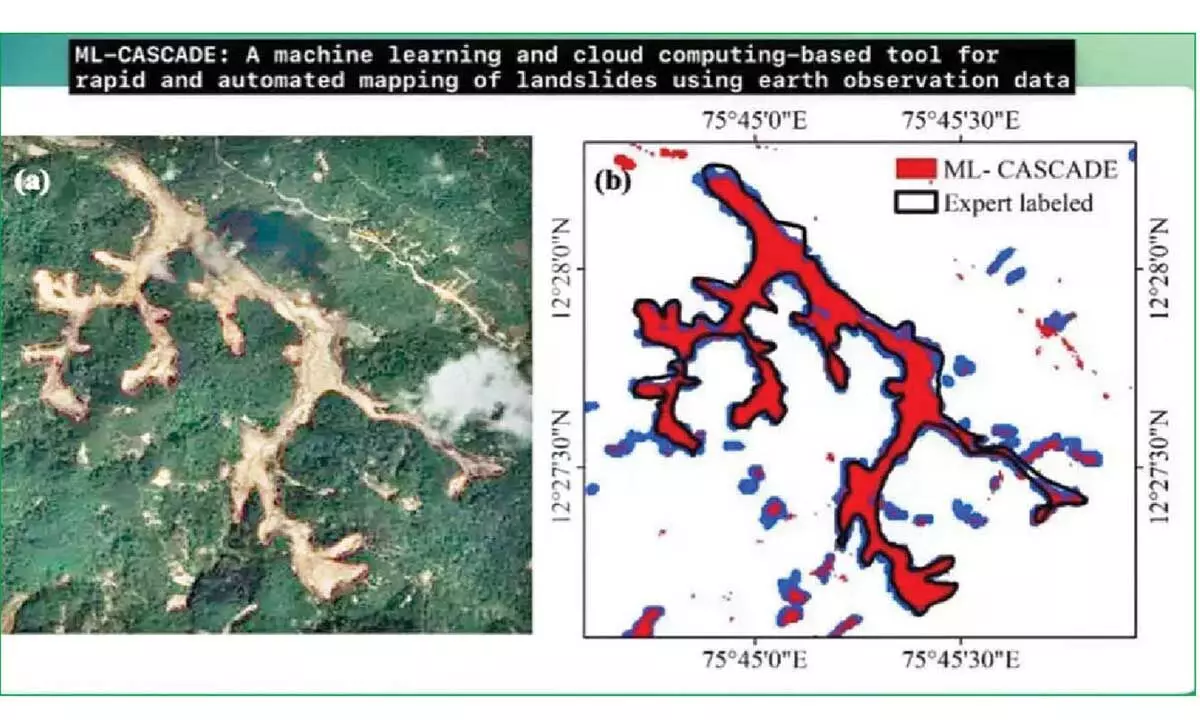Live
- Jamili polls a threat to regional parties
- MLA Yennam pushes for corpn tag for Mbnr municipality
- Officials told to give priority to tribal issues
- Govt should drop tiger corridor proposal: BJP
- Amazon Offers iPhone 16 Pro 256GB Model at Rs 8,870 Off
- Defying Gazette, GO, Kavitha performs ‘bhoomi puja’ for Telangana Thalli statue
- Hundreds take part in Giri Pradakshina
- Phase III of eCMM project, game-changer in dispensation of justice administration: Centre
- Alphores’s Math Olympiad test conducted
- Naini extends support to IRCS services
Just In
IIT Delhi researchers develop ML tool to map extent of landslides


The tool is a dynamic machine-learning model that does not depend on pre-trained models. Instead, it builds a custom model based on user-provided inputs and satellite imagery.
The tool is a dynamic machine-learning model that does not depend on pre-trained models. Instead, it builds a custom model based on user-provided inputs and satellite imagery. It adapts to local terrains and specific environmental factors. Further, the tool’s user interface has been designed in consultation with both technical and non-technical users to provide a simple and practical tool to disaster managers. It can be easily downloaded in multiple image formats, and be disseminated or used for further processing in GIS. It has Google Earth Engine as a backend, and thus requires no downloading of data
New Delhi: Researchers from the IIT Delhi announced the development of a ground-breaking cloud computing and machine learning-based tool that can help map a landslide’s extent using satellite data.
This easy-to-use and publicly-available tool ML-CASCADE requires an approximate date and location of a landslide event.
In case of a complex cluster of landslides, the tool can accurately map it within five minutes. And for a simple landslide, it can map within two minutes -- critical for post-disaster damage assessment.
The underlying model, published in the prestigious Landslides journal, is trained on a large amount of satellite, terrain, vegetation, and soil data.
“Machine learning on geospatial data offers an unprecedented opportunity to overcome the drawbacks of index-based methods and integrate multiple diverse datasets to map landslides with high accuracy,” said Prof. Manabendra Saharia, Civil Engineering Department, IIT Delhi.
Saharia explained that landslides have traditionally been mapped by manually digitising over satellite imagery, which is costly, inaccurate, and time-consuming. However, field surveys and geological data collection cannot be done in large and remote areas.
ML-CASCADE was developed using 19 features with Sentinel-2 bands (pre- and post-landslide), and slope. It also included data from the NASA Digital Elevation Model, Normalised Difference Vegetation Index (NDVI), and differential Bare Soil Index – to detect fresh landslide development.
The tool is a dynamic machine-learning model that does not depend on pre-trained models. Instead, it builds a custom model based on user-provided inputs and satellite imagery. It adapts to local terrains and specific environmental factors. Further, the tool’s user interface has been designed in consultation with both technical and non-technical users to provide a simple and practical tool to disaster managers. It can be easily downloaded in multiple image formats, and be disseminated or used for further processing in GIS. It has Google Earth Engine as a backend, and thus requires no downloading of data.
The outputs take only minutes to generate, which would take hours on a local computer. The study extensively validated the tool over thousands of landslides, with two major events in the Himalayas (Kotrupi landslide, 2017) and Western Ghats (Kodagu landslide, 2018).
Using the tool, the IIT Delhi researchers aim to develop a national historical landslide inventory with spatial extents, which will be invaluable in developing landslide early warning systems. The ML tool can also be applied in mapping flood inundation, deforestation, sand mining, and other environmental challenges, the researchers said.

© 2024 Hyderabad Media House Limited/The Hans India. All rights reserved. Powered by hocalwire.com






